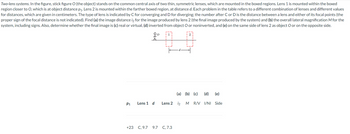Question

Transcribed Image Text:Two-lens systems. In the figure, stick figure O (the object) stands on the common central axis of two thin, symmetric lenses, which are mounted in the boxed regions. Lens 1 is mounted within the boxed
region closer to O, which is at object distance p₁. Lens 2 is mounted within the farther boxed region, at distance d. Each problem in the table refers to a different combination of lenses and different values
for distances, which are given in centimeters. The type of lens is indicated by C for converging and D for diverging; the number after C or D is the distance between a lens and either of its focal points (the
proper sign of the focal distance is not indicated). Find (a) the image distance is for the image produced by lens 2 (the final image produced by the system) and (b) the overall lateral magnification M for the
system, including signs. Also, determine whether the final image is (c) real or virtual, (d) inverted from object O or noninverted, and (e) on the same side of lens 2 as object O or on the opposite side.
옷으
P1
Lens 1 d
+23 C, 9.7 9.7
Lens 2
C, 7.3
(a) (b) (c) (d) (e)
i2 M R/V I/NI Side
Expert Solution
This question has been solved!
Explore an expertly crafted, step-by-step solution for a thorough understanding of key concepts.
This is a popular solution
Trending nowThis is a popular solution!
Step by stepSolved in 5 steps

Knowledge Booster
Similar questions
- The focal points for a double convex lens are located 15 inches from the optical center. A 6 inch tall object is located 10 inches from the optical center one the left side of the lens. How far from the optical center is the image located? What is the image height? What is the magnification of the lens? a) = ________________ inch b) = _______________ inch c) The magnification is ________________arrow_forwardA converging lens has the focal length of 20 cm. For two object distances, 30cm and 10cm, draw the ray diagrams and find the image distances and magnifications. Describe the properties of the image.arrow_forwardPart A Where would you find an image from a convex mirror if s→00? Part B Where would you find an image from a concave mirror if s→00? Answer both parts using the following options: a There will be no image (s'→∞). b A real image would be created distance f away from the lens C d e A virtual image would be created distance faway from the lens A real image would be created very close to the mirror's surface (s'→0) A virtual image would be created very close to the mirror's surface (s'→0)arrow_forward
- Please show all the steps.arrow_forwardCase 5: Object located in focus (d0= F'). The figure below shows an arrow-shaped object, placed in front of a convex lens at a distance d0 equal to a focal length (d0=F'). Draw the following rays in the figure: ray parallel to the optical axis, central ray. Don't forget to put the direction on each ray, both the incident rays and the transmitted rays. Label each ray with its name. Image characteristics for Case 5: Object located in focus (d0= F'). Choose the ones that apply: a) Virtual b) Real c) Inverted d) Increased e) No image is formed f) Equal size g) Reduced h) Erect Case 6: Object located between the focus and the vertex of a convex lens (d0< F'). The figure below shows an arrow-shaped object, placed in front of a convex lens at a distance d0 less than a focal length (d0<F'). Draw the following rays in the figure: ray parallel to the optical axis, focal ray, central ray. Draw the image of the arrow, indicate in the same figure from where to where di is (image-lens…arrow_forwardConsider the compound optical system shown in the diagram, where two thin lenses of focal lengths 7.5 cm (left lens) and 35 cm (right lens) are separated by a distance 25 cm. If a 2.9 cm tall object is placed as indicated in part (a), and the image formed is 0.74 cm tall, what is the magnification of the first lens? M1 = b. Using the information from part (a), calculate the image distance, in centimeters, from the first lens. di1 =arrow_forward
arrow_back_ios
arrow_forward_ios